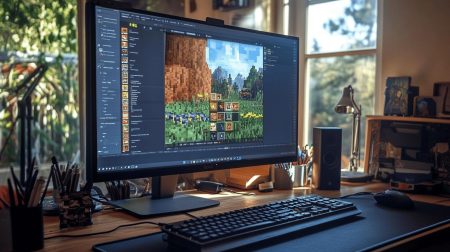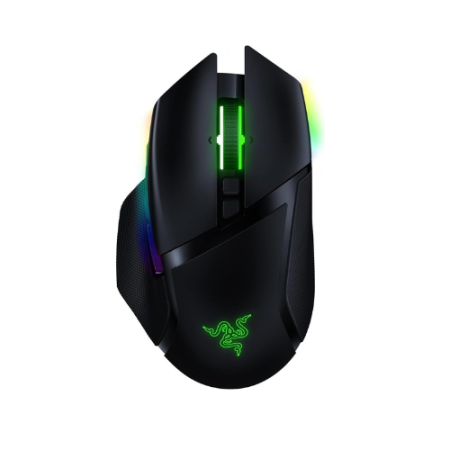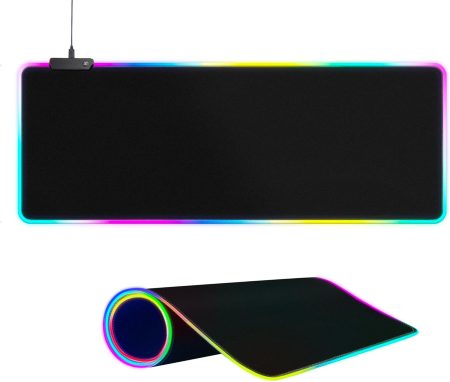This article explores what fps is good for gaming (Frames per second). If you are new to gaming and have recently joined some gaming clubs, you might need help with the gaming experts’ confusing terminology. Remember that the most popular word in the gaming world is FPS, or frames per second, and gamers love to argue about which frame rate is best when trying the latest PC games.
Here is an ultimate guide for a deeper understanding of how vital frame rate is for a thrilling gaming experience, including a comparison between a few types of frame rates and some tips and tricks to get started.
What Is Frame Rate Per Second In Games?
In gaming, “frames per second” (FPS) refers to the number of frames or images a GPU or gaming console can generate within one second. It measures the speed at which a game’s graphics are rendered on the screen. Still, how many frames are you trying to comprehend?
For example, your PC can have 30 FPS for a particular game, meaning it will show 30 different images per second on your computer monitor. If it’s a 1FPS, that is obviously impossible, but for the sake of an example, it will show one image per second, like how many images are in a slideshow. The maximum amount of images you can see per second can be checked by the refresh rate of your PC.
Hence, the algorithm is simple; the more powerful your gaming PC, the higher your frame rate, and the more exciting the gaming experience gets. A higher FPS means smoother and more fluid gameplay, while a lower FPS can result in choppy and stuttering animations.
Top 10 Selling Competetive Shooting & Multiplayer Games In 2023
1. Apex Legends

It is one of the best modern games offering a high PC frame rate for gaming it. Apex Legends have satisfying gunplay, and its fast-paced movements make it a strong competitor and best-seller in the gaming community.
GPU: Nvidia GeForce GTX 640 OR AMD Radeon HD 7730
GPU RAM: 8GB
Max Frame Rate: 300 FPS
CPU: Intel Core i3-6300 3.8GHz
2. Destiny 2

Destiny 2 is a massive action Multiplayer shooter with mythical legends and many intriguing characters and dimensions.
GPU: Nvidia GeForce GTX 660 OR AMD Radeon HD 7850
GPU Ram: 8GB
Max Frame Rate: 300 FPS
CPU: Intel Core i5 2400
3. Call of Duty: Modern Warfare 2

This is the game loved and played by almost everyone. Modern Warfare 2 is the latest version with exciting missions, graphics and updates.
GPU: Nvidia GeForce GTX 960
GPU Ram: 12GB
Max Frame Rate: 120 FPS in 4K
CPU: Intel Core i5-6600K
4. PUBG

Due to its intense and action-packed matches, the game has become a sensation in the esports world.
GPU: Nvidia GeForce GTX 960
GPU Ram: 16GB
Max Frame Rate: 144 FPS
CPU: Intel Core i5-6600K
5. Overwatch 2

Overwatch 2 is a hero shooter game featuring old and new characters with unique tactical abilities.
GPU: Nvidia GeForce GTX 1060
GPU Ram: 8GB
Frame Rate: 300 FPS
CPU: Intel Core i7
6. Back 4 Blood

Back 4 Blood is the latest zombie game from the Left 4 Dead creators. The game pits you against the Ridden, dangerous zombies out to devour the last vestiges of human civilization.
GPU: Nvidia GeForce GTX 970
GPU Ram: 12GB
Frame Rate: 144 FPS
CPU: Intel Core i5-8400
7. Doom Eternal

As players slay hordes of Hell’s worst creatures, Doom Eternal transforms into a lightning-fast shooter game that challenges them to use their imagination.
GPU: NVIDIA GeForce GTX 1060
GPU Ram: 8GB
Frame Rate: 1000 FPS (supportable)
CPU: Intel Core i7-6700K
8. Half-Life 2

Half-life 2 is one of the best PC games since 2004. From the eerie Ravenholm streets to the menacing Citadel that dominates City 17 like a steel and glass tyrant. It may have lost some of its sheens with time, but the FPS game is still visually stunning and compelling.
GPU: DirectX 8.1 level Graphics Card
Frame Rate: 300 FPS
CPU: 2.4 GHz Processor
9. Halo: The Master Chief Collection

There are 67 campaign missions in all for The Master Chief Saga games. In addition, each game has its multiplayer modes and maps, totalling more than 120 maps in addition to user-generated Forge content. The best PC version of most games in the venerable Halo franchise is Halo: The Master Chief Collection.
GPU: Intel Core i3-3550
GPU Ram: 8GB
Frame Rate: 120 FPS+
CPU: Nvidia GeForce GTS 450
10. Valorant

Valorant is strongly advised if you’re interested in joining a new competitive scene because it focuses entirely on providing the ultimate gaming experience.
Frame Rate: 1000 FPS
CPU: Core i3-4150
See how all these games can achieve a very high frame rate? Sometimes you might be limited by the hardware at your hand, limiting you to target fps up to 120 FPS or maybe 60 FPS. How about looking at the latest and greatest Nvidia RTX 4090 here[SDAB2]?
Frame Rate And Screen Tearing – How To Fix It?
Screen tearing is a phenomenon that occurs when a game’s frame rate is out of sync with the display’s refresh rate. It occurs when the graphics card sends a new frame to the display in the middle of the refresh cycle, causing two or more frames to appear on the screen at the same time. This results in a visible horizontal line on the screen, which can be distracting and break immersion.
The good news is that screen tearing is fixable, and you can click here [SDAB3] to read more details about it. But we will quickly summarize it for you here.
Many gamers enable Vsync (Vertical Sync) in their games to prevent screen tearing. Vsync synchronizes the game’s frame rate with the monitor’s refresh rate, limiting the FPS to a value the display can handle without tearing. However, enabling Vsync can cause input lag, which can harm gameplay.
Another option for preventing screen tearing is to use a display with variable refresh rates technology, such as AMD FreeSync or NVIDIA G-Sync. These technologies enable the display to synchronize its refresh rate with the game’s FPS, removing screen tearing while introducing no input latency. However, a display that supports these technologies may be more expensive than a standard monitor.
30 FPS Vs 60 FPS Vs 120 FPS – All The Differences You Need To Know
A great visual is what every gamer craves; it not only elevates the gaming experience but is also crucial as it gives a competitive edge to professional gaming experts.
Frame rate plays a significant role in making this wish come true. Therefore, we have done a detailed comparative analysis of what each FPS feels like and which frame rate is ideal for your PC gaming.
30 FPS – Ideal For Tv Displays In Stadiums Or Concerts
30 FPS is the minimum rating a PC gaming can offer but is not considered suitable for a video game nowadays. It might be the ultimate gaming experience when it was first introduced in your grandparent’s time in the 1930s.
Still, Gen Z has refused to use this minimum level since it is not designed to provide the most optimal experience. Hence, it is commonly used for live tvs, like news shows, sports, and concerts.
60 FPS – Offers Great Visual Experience
For a long time, 60 FPS has been the preferred standard. Today, most modern Television screens and laptops come accustomed to a 60Hz refresh rate, allowing you to enjoy 60FPS video and gaming visual performance.
For regular and casual gamers, 60 FPS is enough for a great visual experience for video games that are not too graphically demanding. But, again, professionals need the best, as when we compare 60 FPS with 120 FPS, you will notice that 60 FPS is comparatively more blurry and less smooth.
120 FPS – The Epitome Of FPS
It won’t be wrong to say that for now, the father of the frame rate is 120 FPS. Thanks to its smoother graphical motions, clear visuals, and reduced latency, PC gamers can now peacefully enjoy their Saturday nights, competing and enjoying PC gaming.
Remember that upgrading to 120 FPS requires a significant investment in your gaming system, but passionate, competitive gamers believe it is worthwhile. Professional gamers prefer 120 FPS over 60 FPS when playing fast-paced competitive games.
120 FPS is the most recurring frame rate that an average gamer aims to achieve. Whether they are on a budget (1080p 60 FPS) or want a high resolution – 1440p or 4k at 120 FPS – this is the best fps and what most people usually target.
However, many professional gamers won’t be satisfied if they get below 300 FPS. This is why they are looking for an Nvidia RTX 4090 [SDAB4] – the current boss of all gaming graphics cards.
60 FPS Vs 120 FPS – Comparing Field View, Latency, and More!
1. Field View
60 FPS provides a decent field view for single-player or non-competitive multiplayer games, but for shooting games like Call of Duty or PUBG, you will need a detailed view of your enemies, for which 120 FPS is preferred by most gamers, who are ready to make hefty investments.
2. Latency
The latency difference significantly affects your performance in a competitive multiplayer hack-and-slash, racing, first-person shooter, or reflex-based games.
A player who plays at 120 FPS will experience more excellent responsiveness and be able to react much faster than a player who plays at 60 FPS.
3. Graphics
While most old games display graphic details and motions flawlessly at 60 frames per second, the same cannot be said for matches from this decade and the ones that will follow.
Some of these graphically demanding games have visual effects that are so intricate and detailed that 60 frames per second are insufficient to render them correctly. As a result, during this rendering process, you might encounter pixelated effects or frame drops.
Now that you know why we declared 120 FPS as the father of frame rates, here’s some advice. If you are a casual gamer, we suggest you not upgrade to 120 FPS as it requires special equipment like a more robust CPU and GPU, costing you a huge fortune.
How Important FPS Is In PC Gaming – What’s The Hype For?
There has been a lot of hype around FPS in PC gaming, and for good reasons. With advancements in hardware technology, gamers can now achieve higher FPS, making games look more realistic and immersive.
Moreover, with the rise of esports and competitive gaming, high FPS has become necessary for many gamers who want to stay competitive. Here are the top 5 benefits FPS offers:
1. Smooth Gameplay
One of the primary reasons why good FPS itself is essential in PC gaming is to ensure that gameplay is smooth and uninterrupted. The higher the FPS, the smoother the game will appear on your screen. This means you will experience fewer lags or delays in the game, and the gameplay will feel more responsive. If you want to know how to reduce input lag and screen tearing, read this [SDAB5] detailed guide to learn more about the differences and ways to fix them.
2. Better Graphics
High FPS makes the game smoother and enhances the game’s graphics. With higher FPS, the game’s visual effects, animation, and lighting will look more realistic, and the overall gaming experience will be more immersive.
3. Competitive Advantage
In competitive gaming, where every second counts, having a high FPS can give you a significant advantage over your opponents. With a higher frame rate, you will have a faster reaction time, and your movements will be more precise, giving you an edge over other players with lower FPS.
4. Reduced Eye Strain
Low FPS can cause eye strain and headaches, especially when playing games for extended periods. Higher FPS reduces the stress on your eyes, making it easier to play games longer without discomfort.
5. Reduced Ghosting
All LCD-type displays to experience the annoying effect of ghosting. The display does not instantly change colours when it refreshes. The pixels take some time, especially when the colour change range is broad.
For this reason, rotating your character or seeing an object in motion is much more apparent at higher FPS. Reduced ghosting offers clearer target tracking, which helps your eye focus on the target rather than the ghost. This benefit is similar to that of animation smoothness.
How To Improve FPS In PC Gaming?
1. Upgrade Your Hardware
Hardware upgrades are the most efficient way to increase FPS. Consider upgrading your graphics card, processor, and RAM to increase your games’ frame rate significantly. A more potent processor can manage complex calculations and interactions, and a more expensive graphics card can render images more quickly. Additionally, increasing your RAM can give your system more memory to run memory-intensive applications.
2. Optimise Game Settings
Another way to improve FPS is by optimizing the game settings. Lowering the graphics settings, reducing the resolution, and disabling features like anti-aliasing can improve the FPS of your games. By reducing the strain on your system, you can achieve smoother gameplay while maintaining a decent level of visual quality.
3. Close Background Programs
Multiple programs running in the background can deplete system resources and lower FPS. The frame rates of your games can be increased by closing unnecessary programs and freeing up resources. While playing games, make sure to close any applications that may be running in the background by checking your task manager.
4. Update Your Drivers
FPS can be increased by updating the drivers for your graphics card. Updates released by manufacturers regularly improve the performance of graphics cards. You can ensure your hardware is functioning to its full potential by keeping your drivers up to date.
5. Keep Your Setup Clean
Keeping your setup clean can also help improve your FPS. Physically cleaning your setup with a blower can remove dust or debris affecting your hardware’s cooling. Digital cleaning involves removing unnecessary clutter running in the background, such as browser extensions or background processes.
6. Use AMD and Nvidia’s Proprietary Software
AMD and Nvidia provide proprietary software to improve FPS and reduce screen tearing. For instance, AMD’s Radeon Software Adrenalin offers features such as Radeon Anti-Lag, which reduces latency, and Radeon Chill, which dynamically regulates FPS to conserve power and reduce heat.
Nvidia’s GeForce Experience offers similar features, such as Game Ready Drivers, which optimize game settings for your computer graphics hardware, and ShadowPlay, which lets you record and stream gameplay. Nvidia’s RTX 4090 is one of the best graphic cards in the market. Click here to learn more about RTX 4090.
Nvidia’s latest DLSS 3 technology is a game changer in the 4090 RTX GPUs. Take a peek at the video below to learn more.
FAQs
Why Does The Frame Rate Of A Video Game Matter?
When you need to change your audience’s viewing experiences while keeping several things in mind, like using a realistic or slow-motion technique, frame rates are very important.
Which Frame Rate, 60 Or 30, Is Preferable?
The number of frames offered on the screen per second is the primary distinction between these two FPS, 60 per second and 30 per second. Better details directly result from higher frame rates, which are highly demanded by gamers.
However, people use a frame rate of 24 or 30 fps for regular TV screens to keep things realistic, whereas 60 fps capture fast and quick movements in games.
Does Frame Rate Impact The Quality Of Videos?
The resolution in which you record the video is completely responsible for the video quality. Therefore, FPS has no bearing on the calibre of your video.
Does Video File Size Depend On Frame Rate?
The quantity of displayed frames per second is called the frame rate. As a result, the frame rate you select will significantly affect the size of extra frames in your final video file.
Final Thoughts
In conclusion, FPS is a crucial PC gaming factor affecting the overall gaming experience. With higher FPS, you can enjoy smoother gameplay, better graphics, and a competitive advantage in gaming.
While upgrading your hardware is the most effective way to improve FPS, optimizing game settings, closing background programs, and updating drivers can also help. With the hype surrounding FPS, we can expect to see even higher FPS in the future, making gaming more immersive.














